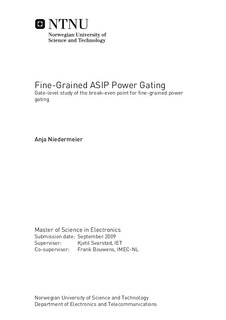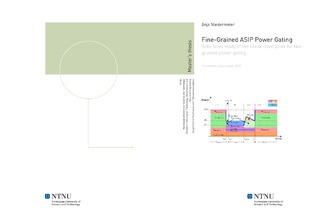| dc.description.abstract | Power consumption in portable electronic devices is a crucial design factor. While technology at 90~nm and above is still dominated by dynamic power, it is expected that leakage power will gain importance in sub-90~nm technologies. One commonly used technique to reduce leakage power is power gating, which is still an active research topic, especially on the fine-grained level.The purpose of this thesis was to explore the impact of fine-grained power gating on the datapath of a VLIW processor. Also, a detailed analysis of the savings versus introduced overhead was performed to derive a generic formula for a quick estimation of the energy efficiency of power gating. During the work, a work-flow to partition the system into power domains was developed. Furthermore, a verification method was implemented that validates whether a power gated resource is scheduled by the compiler or not. A configurable HSPICE simulation flow was implemented to determine how many power switches were required for a specific power domain as well as the energy consumption to switch a power domain on.Two processors with different usage profiles, designed with the help of different tools, were investigated in this thesis. The processors were modified to support power gating, and, furthermore, a synchronous power manager was developed. After RTL-level verification of functional correctness, the resulting systems were synthesised and placed and routed for 100 Mhz with two different 90nm TSMC libraries (low power and general purpose) to evaluate the variation between different technology flavours. The results showed, that a large contributor to the energy overhead of power gating is the dynamic power of additionally required modules, e.g., the isolation cells at the output of a power domain and the power manager. Also it was proven that the power domains need a very low duty cycle in order to apply power gating efficiently. It has been shown that the energy overhead for fine-grained power gating is significant and it is mainly caused by additional modules that have to be added to the system. Therefore, power gating can only be beneficial on designs with sufficient large power domains with a low duty cycle. However, it must be said that power is mainly consumed by the memories. Also, for 90~nm, leakage power is a rather small fraction of the total power consumption. The possible overall savings when focussing on the datapath are therefore very limited. | nb_NO |

